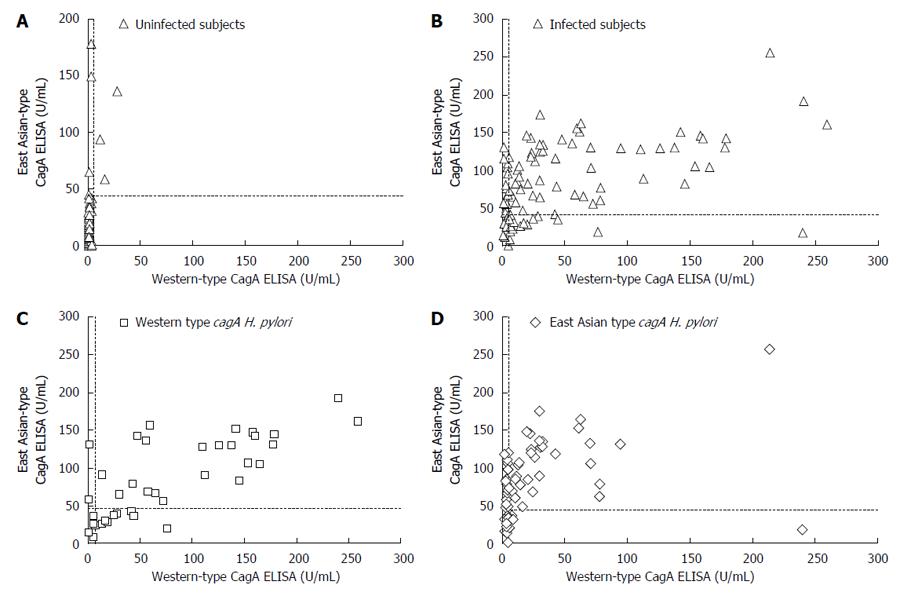Copyright
©The Author(s) 2017.
World J Gastroenterol. Jan 7, 2017; 23(1): 48-59
Published online Jan 7, 2017. doi: 10.3748/wjg.v23.i1.48
Published online Jan 7, 2017. doi: 10.3748/wjg.v23.i1.48
Figure 5 Relationship between the two types of CagA antibody ELISA titers.
Dotted lines indicate the cut off values (6.25 U/mL for Western-type CagA ELISA and 45.0 U/mL for East Asian-type CagA ELISA). A: Scatter plot of uninfected subjects. Of the 107 Helicobacter pylori (H. pylori) uninfected subjects, 104 subjects (97.2%) were negative by Western-type CagA ELISA and 100 subjects (93.5%) by East Asian-type CagA ELISA; B: Scatter plots of infected subjects. Of the 110 H. pylori infected subjects, 69 (62.7%) subjects were positive by Western-type CagA ELISA and 78 (70.9%) by East Asian-type CagA ELISA; C: Scatter plot of Western-type cagA H. pylori infected subjects. Of the 38 subjects infected with western-type cagA H. pylori, 32 subjects (84.2%) were positive by Western-type CagA ELISA and 25 subjects (65.8%) were positive by East Asian-type CagA ELISA; D: Scatter plot of East Asian-type cagA H. pylori infected subjects. Of the 72 subjects infected with East Asian-type cagA H. pylori, 53 subjects (73.6%) were positive by East Asian-type CagA ELISA and 37 subjects (51.4%) were positive by Western-type CagA ELISA.
- Citation: Matsuo Y, Kido Y, Akada J, Shiota S, Binh TT, Trang TTH, Dung HDQ, Tung PH, Tri TD, Thuan NPM, Tam LQ, Nam BC, Khien VV, Yamaoka Y. Novel CagA ELISA exhibits enhanced sensitivity of Helicobacter pylori CagA antibody. World J Gastroenterol 2017; 23(1): 48-59
- URL: https://www.wjgnet.com/1007-9327/full/v23/i1/48.htm
- DOI: https://dx.doi.org/10.3748/wjg.v23.i1.48









